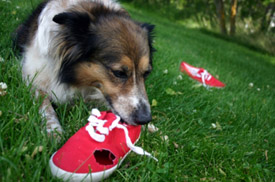| D.I.Y. Complete Home Dog Training System - FREE online coursehere | |
Home Dog Training Books Barking Biting Chewing Dog Training Tips House Training |
DIY Dog Training Managing Chewing!
Hi there. It's Sharda Baker here, welcoming you to our Dog Training article on Chewing.
What Are Some Causes of Dog Chewing?It is very common for puppies to chew when they are teething. The act of chewing helps their teeth break through the gums. Older dogs, generally chew if they are bored or anxious. If a dog is bored, it is because he has built up so much energy, but has run out of ways to exert it. So he finds something interesting to chew. The only problem is, is that he doesn’t know what is permissible to chew unless you have taught him. So the sooner you teach him, the less likely he will chew your household items. A dog may also chew if he has been left alone and not within the comfort of his own crate. This is known as a “spite chewer.” He is upset that you have left him so he will start chewing as soon as you leave. By keeping your dog in a crate when you leave your house, you are not “punishing” him, rather you are keeping him in a safe and comfortable environment. You can place lots of fun chew toys in the crate to keep him occupied while you are away. If you don’t keep him in a crate while you are gone and instead let him roam about, he will help himself to chew on anything he wants! When you return home to find that your dog is in the act of chewing something he shouldn’t be, give a sharp “no,” but do not yell. Take the object away and ignore him for five to ten minutes. If you start to play with him or feed him, he will think he is being rewarded for the chewing.
Prevent Chewing
There are some proactive steps you can take to help eliminate the act of chewing. These steps can be used by puppies and adult dogs. Puppy-proof – you need to puppy-proof your home. Even if your dog is older, you still need to take precautions to make potentially-destructive objects out of your dog’s reach. Provide Toys – Make sure your dog has a plentiful selection of chew toys available to him at all times. Provide Sound – Instead of turning off the television or radio when you leave the house, turn them on. The extra background noise will help your dog feel more at ease. Increase Exercise – Providing your dog with frequent exercise will help him burn off excess energy that he could otherwise use towards items in your home. For further information, please consider see the popular DIY Dog Training Package This dog training and health package includes advanced training help plus other extensive helpful resources for best caring for your dog. There is also a FREE Training online dog training course available. All the best in all your dog endeavors warmly, Dedicated To Making All Of Your Dog Experiences Happy Ones!
|

